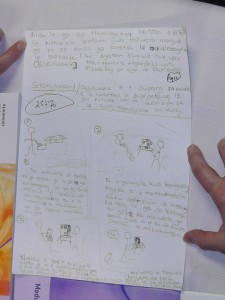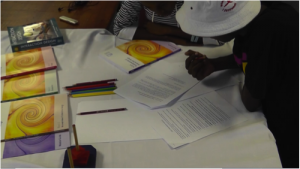
During 2012, we conducted two pairs of studies, one in Botswana and one in the UK, with students who were studying the same Interaction Design undergraduate module from The Open University UK. In all studies, participants were asked to focus on designing an interactive product that would remind home-based patients to take their medicine on time. The first of the pair was a constrained task protocol study in which participants were asked to complete an interaction design task in a limited amount of time. The resultant protocols were analysed to investigate detailed design behaviours of our participants using a new approach to protocol analysis based on Schön’s design reflection cycle, specifically tailored towards interaction design. The second study comprised a video diary conducted over a four-week period.
The video diaries and design prototypes were analysed to identify socio-cultural factors that affect the design process and product. During 2013 we conducted workshops with local educators (one in Botswana and one in the UK) to identify pedagogical patterns related to the identified behaviours. Our overall findings so far show that:
- both cohorts developed credible designs of good quality in both studies.
- novice interaction designers exhibit behaviours that are often associated with expert designers, e.g. co-evolution of solution and problem. Botswana participants favoured solution-problem co-evolution and start with an ‘off the shelf’ solution; UK participants favoured problem-solution co-evolution and start by investigating the problem.
 for our participants solution-problem co-evolution led to many ‘leaps’ or bridges between the problem and solution spaces, while problem-solution co-evolution tended to progress further within each space.
for our participants solution-problem co-evolution led to many ‘leaps’ or bridges between the problem and solution spaces, while problem-solution co-evolution tended to progress further within each space.- preferred ideation techniques differ between the two cohorts. UK participants used sketch-based ideation techniques, e.g. storyboards, more than non-sketch based techniques, e.g. scenarios. Botswana participants exhibited a greater balance between sketch and non-sketch based techniques.
- there is no consensus on which behaviours we identified should be encouraged and which discouraged, but they all had been observed by local educators in their own students, and strategies for addressing them could be identified as outline pedagogical patterns.
- a wide range of socio-cultural factors are evident during the video diary design exercise, including carers being elderly and urban versus rural setting. Some of these clearly influenced the final design, e.g. the need for a mobile device because carers have to move about to complete other tasks, while others do not, e.g. some patients stop taking the medication when they start to feel better.